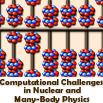Speaker
Wojciech Satula
Description
Over the last few years we have developed the
multi-reference density functional theory (DFT) involving
the isospin- and angular-momentum projections of a single
Slater determinant. The model, dubbed below static, was
specifically designed to treat rigorously the conserved
rotational symmetry and, at the same time, tackle the
explicit breaking of the isospin symmetry resulting from a
subtle balance between the long-range
isospin-symmetry-breaking Coulomb field and short-range
isospin-symmetry-conserving (predominantly) strong force.
These unique features allowed us to calculate, in between,
the isospin impurities in N~Z nuclei and isospin symmetry
breaking corrections (ISB) to superallowed Fermi beta-decay
matrix elements. Recently, we have extended the model to a
variant (hereafter called dynamic) that allows for mixing of
states that are projected from self-consistent Slater
determinants representing low-lying
(multi)particle-(multi)hole excitations. The states that are
mixed have good angular momentum and, at the same time,
include properly treated Coulomb isospin mixing. Hence, the
extended model can be considered as a variant of the no core
configuration-interaction approach, with two-body
short-range (hadronic) and long-range (Coulomb) interactions
treated on the same footing. It is based on a truncation
scheme dictated by the self-consistent deformed Hartree-Fock
(HF) solutions. The model can be used to calculate spectra,
transitions, and beta-decay matrix elements in any nuclei,
irrespective of their neutron- and proton-number parities.
The aim of the talk is to introduce the theoretical
frameworks of both the static and dynamic approaches and
present selected applications. The applications will be
focused on nuclei relevant to high-precision tests of the
weak-interaction flavor-mixing sector of the Standard Model.
In this context, we will present the results for ISB
corrections to superallowed Fermi transitions and for the
low-spin spectra in: 32S and 32Cl nuclei, in A=38 Ar, K, and
Ca nuclei, and in 62Ga and 62Zn nuclei. In case of 62Zn the
spectrum of 0+ states will be addressed. The 0+ states in
this nucleus were reassigned in a recent experiment, and are
now posing a challenge to theory.

